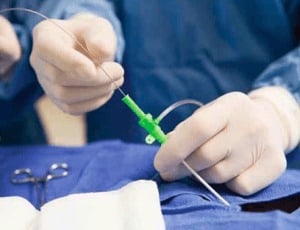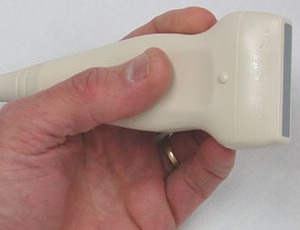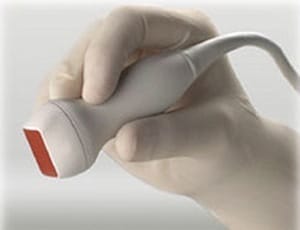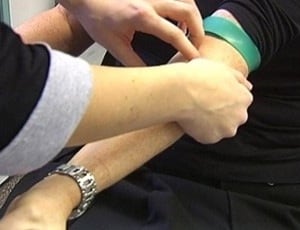Comparison of different ultrasound techniques for jugular venous catheterization

Internal jugular venous catheterization (IJVC) is performed for numerous therapeutic interventions. Although ultrasound-guided IJVC is the gold standard for this procedure, complications can still occur” Chen et al (2018). Abstract: BACKGROUND: Internal jugular venous catheterization (IJVC) is performed for numerous therapeutic interventions. Although ultrasound-guided IJVC is the gold standard for this procedure, complications can still […]
Review of a pocket-sized ultrasound device for internal jugular puncture

The aims of our study were to compare the performance of experienced emergency physicians for internal jugular vein puncture using a conventional ultrasound device versus a pocket-sized ultrasound in a training model” Chetioui et al (2018). Abstract: INTRODUCTION: The aims of our study were to compare the performance of experienced emergency physicians for internal jugular […]
Central venous occlusive disease in patients with end-stage renal disease

Central venous occlusive disease is frequently observed in patients with end-stage renal disease” McFall and Lu (2018). Abstract: Central venous occlusive disease is frequently observed in patients with end-stage renal disease. Venography remains the gold standard for diagnosis, but intravascular ultrasound is a potentially beneficial adjunct that may positively influence intervention. You may also be […]
Options for difficult central venous cannulation insertion?

A commonly encountered difficulty during US-guided cannulation is the small lumen of the vessel (especially internal jugular vein) in patients who are volume deficient or have a history of multiple cannulations” Dhiman et al (2018). Extract: “A commonly encountered difficulty during US-guided cannulation is the small lumen of the vessel (especially internal jugular vein) in […]
Ultrasound peripheral IV catheter insertion reduces central line placement

Our primary objective was to determine the proportion of patients that required CVC after USPIV. Our secondary objective was to determine if classic risk factors for difficult vascular access were predictive of future CVC placement” Pare et al (2018). Abstract: Objectives: Ultrasound guided peripheral intravenous catheters (USPIV) are frequently utilized in the Emergency Department (ED) […]
Review of ultrasonography in Italian anesthesiology

The appropriate training in the use of ultrasound in anesthesia, intensive-care medicine, and pain therapy should be implemented in south of Italy to make uniform the widespread of ultrasonography in anesthesia, in all Italian regions” Fusco et al (2018). Abstract: PURPOSE: In recent years, ultrasound has seen a rapid development with numerous applications in anesthesia, […]
Implications of head turning on central venous access

The goal of this study was to examine the anatomical relationships of the IJV and CA as a function of the degree of head rotation in order to minimize the risk for CA puncture” Merritt et al (2018). Abstract: CONTEXT: Previous studies have shown that safe venous cannulation is difficult when the internal jugular vein […]
Pythagoras and ultrasound-guided vessel puncture

Reminding about the properties of the isosceles right triangle might be of interest to teach young fellows a secure step by step technique for vessel catheterization” Piton et al (2018). Extract: “Vascular access is routinely performed by critical care physicians and the use of ultrasonography is recommended [1]. However, complications during vessel puncture are not […]
Ultrasound use in neonatal peripheral intravenous extravasation injuries

The primary aim of this study was to examine and describe peripheral intravenous extravasation (PIVE) injuries using point-of-care ultrasound (POC-US). A secondary aim was to define skin tissue changes before and after hyaluronidase application using POC-US” Boyar et al (2018). Abstract: PURPOSE: The primary aim of this study was to examine and describe peripheral intravenous […]
Guidewire problems during central venous catheter placement

CVC placement was confirmed via plain radiography of the chest Even a flexible guidewire can penetrate the IJV at posterior wall if a puncture needle tip is positioned near the posterior wall Longitudinal ultrasonographic imaging of guidewires can help physicians avoid misplacing dilators” Yamasaki et al (2017). Abstract: A 58-year-old man (height, 160.5 cm; weight […]
Point of care ultrasound in localizing central venous line tip position

The primary objective was to study agreement between X-rays and point of care ultrasound (POC-US) in determining central venous line (CVL) tip position” Zaghloul et al (2018). Abstract: The primary objective was to study agreement between X-rays and point of care ultrasound (POC-US) in determining central venous line (CVL) tip position. The secondary objective was […]
Near-eye display to assist ultrasound guided central venous cannulation

Because head-mounted display can provide the visualized information without moving direction of eye- sight, ultrasound guided central venous cannulation might be performed more quickly and safer” Kasuya et al (2018). Abstract: BACKGROUND: Recently several types of head- mounted displays are available for use in the medical field. Because head-mounted display can provide the visualized information […]
Ultrasound guidance for pediatric central venous catheterization

Ultrasound-guided techniques are associated with a reduced incidence of failures and inadvertent arterial punctures in pediatric central venous catheterization when compared with the anatomic landmark technique” de Souza et al (2018). Abstract: CONTEXT: Central venous catheterization is routinely required in patients who are critically ill, and it carries an associated morbidity. In pediatric patients, the […]
Central venous catheter tip location confirmed with agitated saline bubble-enhanced ultrasound

Dynamic ultrasound-based visualization of microbubbles in the right atrium is a highly accurate method to detect percutaneous implantation of large-lumen, tunneled, central venous catheters without the need for fluoroscopic guidance technology” Passos et al (2018). Abstract: BACKGROUND: In patients with end-stage renal disease, the use of cuffed, tunneled dialysis catheters for hemodialysis has become integral […]
Does ultrasound guidance for PICC insertion reduce the incidence of tip malposition?

The aim of the study was to evaluate the incidence of peripheral inserted central catheter (PICC) tip malposition when the catheter is inserted under real-time ultrasound (RTUS) guidance when compared with conventional landmark (CL) technique in neonates” Oleti et al (2018). Abstract: OBJECTIVE: The aim of the study was to evaluate the incidence of peripheral […]
Nursing competence in ultrasound-guided peripheral intravenous catheter placement

Ultrasound-guided peripheral intravenous catheter placement has many potential benefits and is a viable skill for nurses to learn. The objective of this study was to demonstrate the feasibility and validity of hand motion analysis for assessment of nursing competence in ultrasound-guided peripheral intravenous placement” Good et al (2018). Abstract: INTRODUCTION: Objective measures such as hand […]
Study represents largest analysis of ultrasound-guided access for children

This study represents the largest analysis of ultrasound-guided access for children. A complete practice transition to the ultrasound-guided approach was feasible within a two-year period” Criss et al (2018). Abstract: BACKGROUND: Use of ultrasound-guidance for central venous access in adults is the standard of care. There is, however, less clarity in the role of routine […]
Ultrasound guidance during cannulation of arteriovenous fistulas

The purposes of this project were to determine if ultrasound-guided cannulation of AVFs decreased the number of missed cannulations…” Luehr (2018). Abstract: Individuals who require renal replacement therapy overwhelmingly choose outpatient hemodialysis. Appropriate cannulation techniques are an essential element in access preservation and in the prevention of access-related complications. Missed cannulations can result in damage […]
Animal model to teach ultrasound-guided central venous catheter insertion

The aims of the study were to examine the utilization of an animal model and compare it with two currently used Blue Phantom central line models to determine whether an animal model provides good or better simulated conditions for the performance of UGCVC insertion” Hauglum et al (2018). Abstract: INTRODUCTION: Ultrasound-guided central venous catheter insertion […]
Description of Rapid Central Vein Assessment (RaCeVA)

The ability to visualize underlying structures of the chest, neck, and upper/lower extremities provides for greater success, speed, and safety with all vascular access procedures” Spencer and Pittiruti (2018). Abstract: Ultrasound technology has revolutionized the practice of safer vascular access, for both venous and arterial cannulation. The ability to visualize underlying structures of the chest, […]
Ultrasound protocol to determine the upper extremity PICC location in neonates

To assess whether a limited ultrasound (US) scanning protocol to monitor the upper extremity peripherally inserted central catheter (PICC) location in neonates is feasible for experienced US operators” Motz et al (2018). Abstract: OBJECTIVES: To assess whether a limited ultrasound (US) scanning protocol to monitor the upper extremity peripherally inserted central catheter (PICC) location in […]
Simulation training ultrasound-guided central venous cannulation

This study compared medical residents’ preferences for and performance of ultrasound-guided central venous access using the transverse, longitudinal, and oblique approaches” Caffery et al (2018). Abstract: BACKGROUND: Obtaining central venous cannulation of the internal jugular vein is an important skill for physicians to master. To our knowledge, no studies to date have examined residents’ preferences […]
Ultrasound guided peripheral intravenous access reviewed

The success of ultrasound-guided peripheral intravenous catheters (USGIVs) has been associated with significant reductions in central venous catheter placement in the emergency department[3] as well as enhanced patient satisfaction” Presley and Isenberg (2018). Excerpt: At least 150 to 200 million peripheral intravenous (PIV) catheters are placed each year in the United States, while up to […]
JLB intravenous catheter designed for patients with difficult peripheral venous access

In patients with difficult peripheral venous access, alternative techniques require expertise and are invasive, expensive, and prone to serious adverse events. This brought us to designing a new venous catheter (JLB® Deltamed, Inc.)” Brugioni et al (2018). Abstract: BACKGROUND: In patients with difficult peripheral venous access, alternative techniques require expertise and are invasive, expensive, and […]
Impact of ultrasound guided-central venous access training on CLABSI rates

To address this limitation, we designed and conducted a standardized training course and a performance-based competency examination for all residents at a single institution and assessed the impact on the resident CLABSI rate” Lyon et al (2018). Extract: “Prior research has examined methods and processes for the teaching of ultrasound-guided central venous access (USGVA). None […]
Ultrasound guided IV insertion curriculum for emergency medicine trainees

Ultrasound-guided IV (USGIV) insertion is a safe and effective procedure to obtain access in DIVA patients; however, at our institution, most residents receive only informal instruction” Amick et al (2018). Extract: Establishing venous access in difficult IV access (DIVA) patients is a Accreditation Council for Graduate Medical Education (ACGME) milestone for emergency medicine trainees. Ultrasound-guided […]
Training for ultrasound-guided vascular access to small vessels in neonates

Critically ill neonatal and pediatric patients often require central vascular access. Real-time ultrasound guidance for central venous catheterization is beneficial. Because the diameter of central veins is much smaller in neonates than in adults, extensive training is needed to master the visualization and catheterization of central veins in neonates” Wagner et al (2018). Abstract: OBJECTIVES: […]
Management of CVC associated inadvertent carotid cannulation

We report 2 cases-a 59-year-old Hispanic man and an 86-year-old white man-of inadvertent placement of a CVC into the left common carotid artery, removed via a pull-and-pressure technique under real-time ultrasound guidance” Libricz et al (2018). Abstract INTRODUCTION: Despite ultrasound use, accidental carotid cannulation is possible during placement of a central venous catheter (CVC), requiring […]
Ultrasound transducer disinfection guideline from the Association for Vascular Access

Use of ultrasound for vascular access, particularly peripheral access, presents distinct challenges to existing recommendations. Healthcare professionals responsible for vascular access also have a responsibility to ensure patient safety during those procedures, therefore, they also must address inconsistent practice with respect to cleaning and disinfection practices involving USGVA” Thompson and Garrett (2018). Introduction/Summary: Use of […]
Complication rates of ultrasound guided versus traditional peripheral intravenous catheters

This study analyzed 300 ultrasound-guided peripheral intravenous lines and 552 traditionally placed intravenous lines using patient records to determine the reason and timing for intravenous line removal” Desai et al (2018). Abstract: Background: Ultrasound-guided peripheral intravenous lines are frequently used in patients with difficult access. We have previously reported on the longevity and complication rates […]

